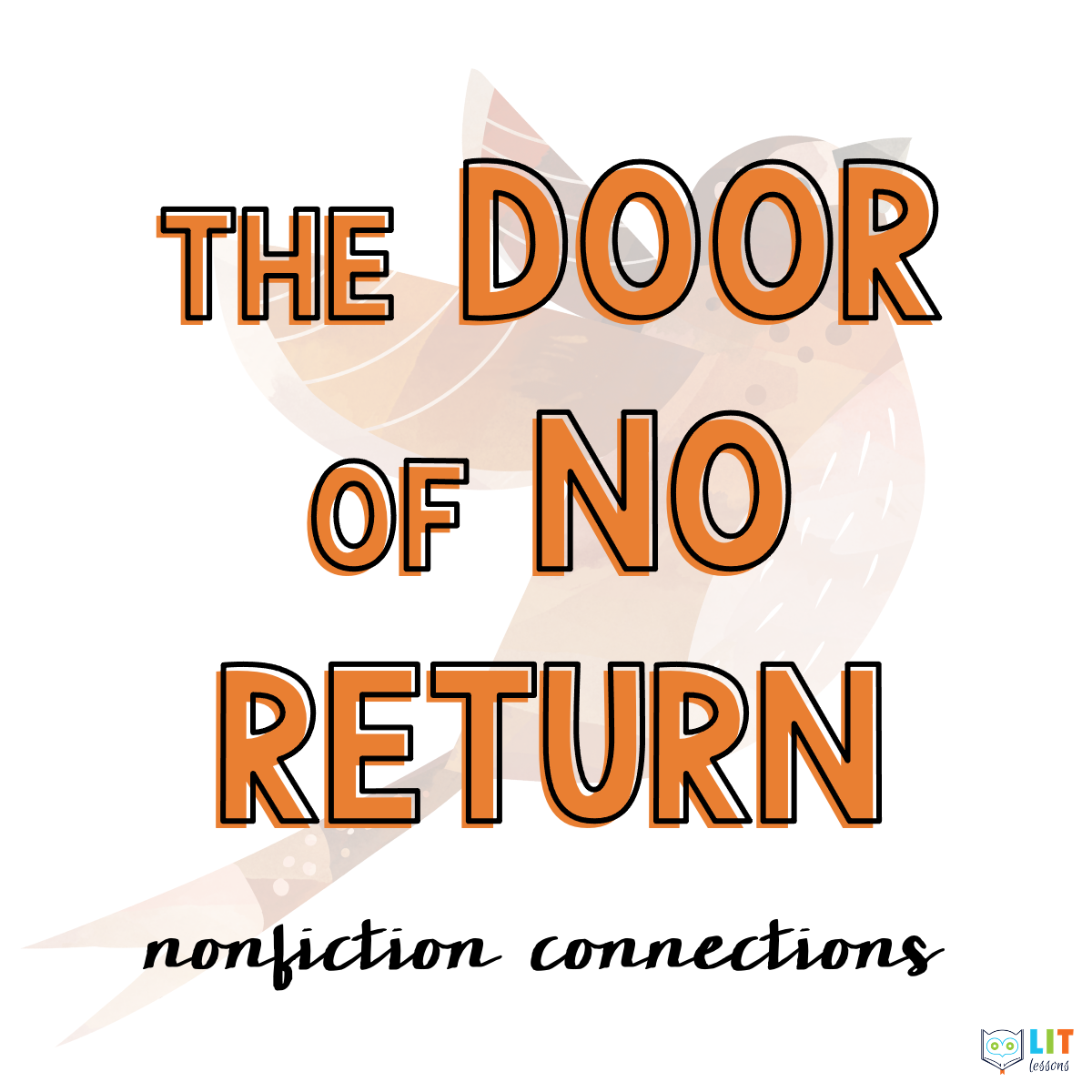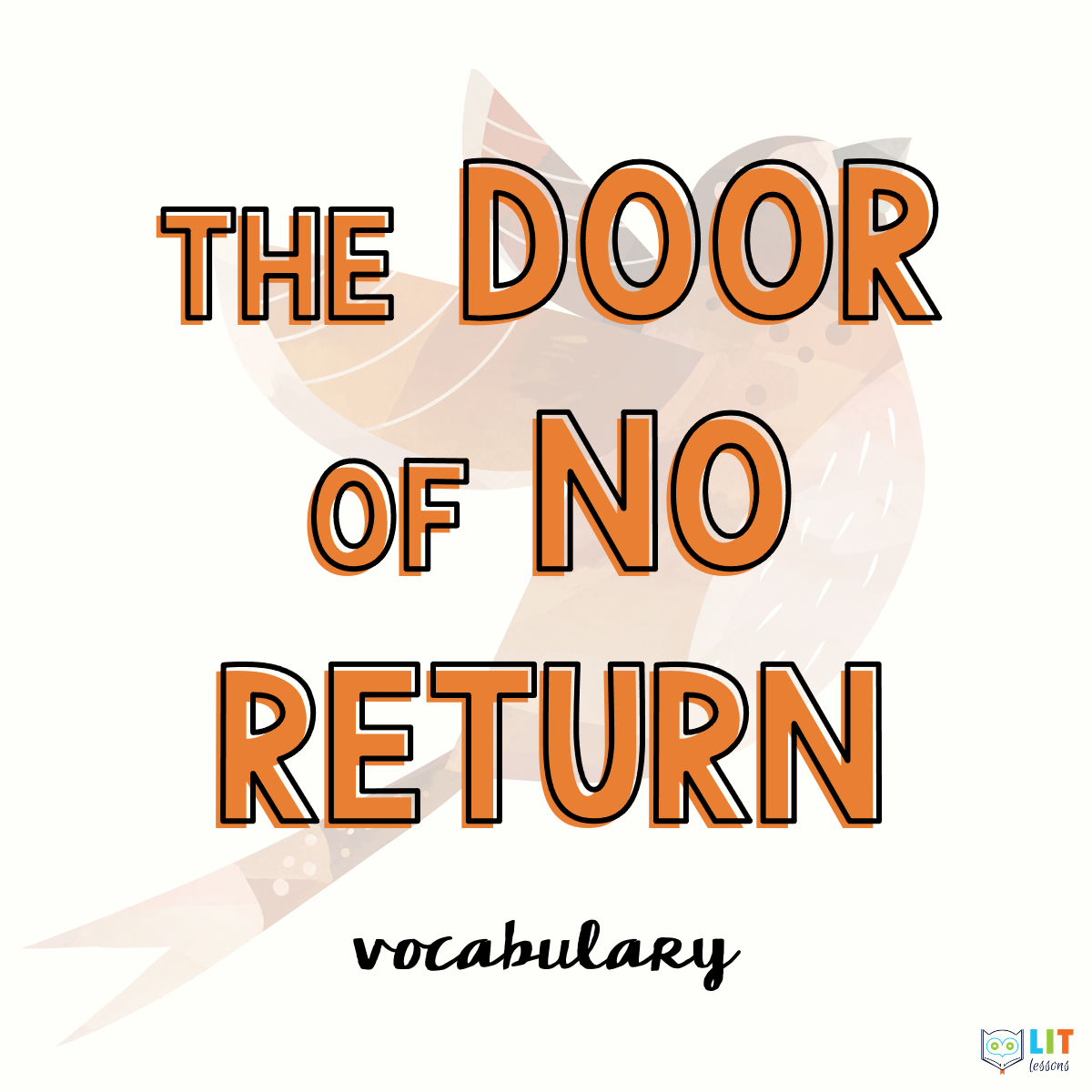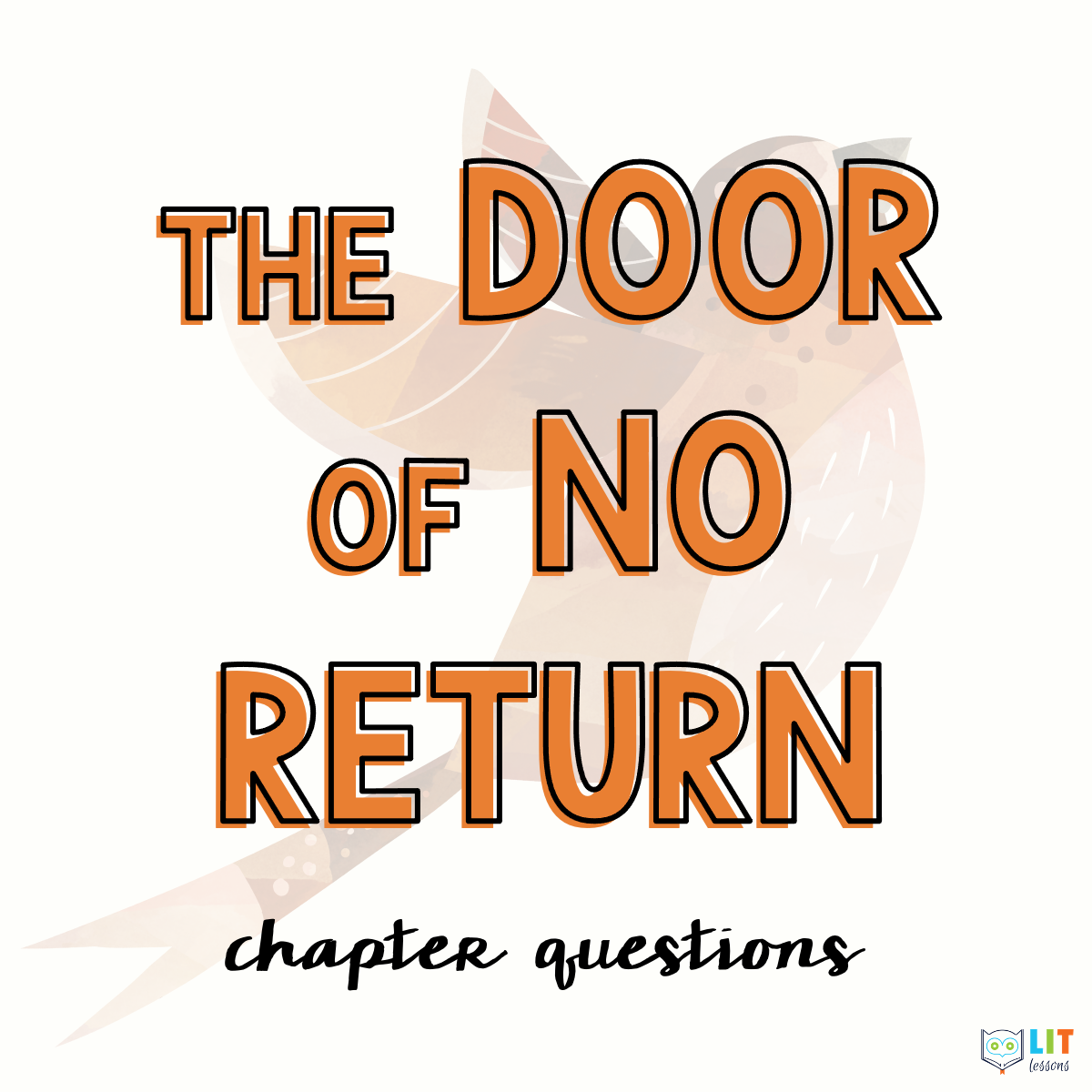The Door of No Return Chapter Questions & Discussion Questions
You can only add to a wishlist if you have an account, please register now.
Create an Account$8
The Door of No Return Chapter Questions & Discussion Questions – Snapshot of Included Resources:
- 12 Comprehension Assignments (A)
- Visualization Organizer (A)
- 12 Analysis Assignments (B)
- Critical Connections Organizer (B)
- 8 Questions per Assignment
- 1-Question Quizzes to Check for Understanding
- Discussion Questions – 12 (1 per Reading) & 8 Whole Novel
- Digital Links for Google Forms™
- Answer Keys
The Door of No Return (Kwame Alexander) chapter questions will give students repeated opportunities to practice essential standards-aligned literacy skills. For every chapter grouping (~ 30 pages), students will have to answer rigorous, text-based questions that assess not only their ability to comprehend but also their ability to analyze key events. With numerous options for implementation, the resource also allows for differentiation and can enable accommodation that will meet the needs of all learners.
Comprehension & Analysis Questions: The Door of No Return differentiated chapter questions can offer several different uses. It could supply homework, facilitate guided reading groups, enable literature circles, or stimulate whole class reading analysis and discussion for each chapter grouping. The flexibility also makes it ideal for offering accommodations to students.
There are two sets of questions for 12 readings: Chapter Questions A (comprehension) and Chapter Questions B (analysis). The twin sets offer different levels of challenge for students to give you options for meeting the needs of all your learners. All 24 assignments include 8 questions that require close reading of the text, which means your students will always be practicing essential skills aligned to the CCSS, such as:
- Identifying main idea and support using details from the text
- Identifying and analyzing how elements of a story interact
- Identify and analyze conflict and types of conflict
- Analyze character and make inferences about character motivation
- Identify themes of the text and explain the lesson learned
- Identify and analyze point of view
- Make inferences based on textual evidence
- Analyze tone and determine the meaning of words, phrases, and figurative language
Chapter Questions A – Visualize the Text Section: Each comprehension assignment also asks students to identify an example of figurative language or imagery and draw a visualization of their example. This is a great way to have students use their imagination and get them to “see” what the author is trying to convey. NOTE: Modified for digital format.
Chapter Questions B – Critical Questions Section: Each analysis assignment includes a graphic organizer for students to identify an aspect of the text that makes them curious. After identifying a reference, description, or event from the novel, students will generate questions about their reference. In doing so, students will develop their critical thinking skills by connecting and questioning topics and issues in the text. The exercise can also serve as a springboard for clarifying misconceptions, research, discussion, and much more.
Discussion Questions: The Door of No Return discussion questions provide open-ended prompts to deeply explore the themes, conflicts, and history prominent in the novel. The resources include one prompt for every reading (12), 1 for the Adinkra stamps, and 8 questions for whole novel analysis. The 12 reading discussion questions are provided in two different formats – graphic organizers and task cards – that will allow flexible implementation. The whole novel discussion questions are provided as task cards. Use the questions for independent work, small group or whole class discussion, reflection, homework, or more.
One-Question Reading Checks: The mini-quizzes are a way to test students’ comprehension of the text. This space can be used for the single question quizzes provided in the resource. There are multiple potential uses that could fit the needs of your classroom. (NOTE: The digital version is not formatted to allow for students to complete the quizzes online. However, as you have access to all the questions, you can still use the content and determine the best method to deliver it.)
Answer Key: The key provides potential answers for every question asked in every assignment. This includes comprehension quiz questions and analytic questions. Of course, not all analytic questions have just one answer. Part of the strength of the analysis question is the room they leave for students to demonstrate their unique thinking. Therefore, use the answers at your discretion but know they provide a solid foundation for the type of performance that makes for quality work.
Google Forms™ Links: This resource is also technology friendly! It can be utilized in classrooms or formats where computers or tablets are central to instruction because the resource has been adapted for digital completion. The resource includes links for students to complete the assignments in Google FormsTM. For instance, students can work with the documents in Google DriveTM or via Google ClassroomTM. With these links, you can have students complete their assignments online. There are links for every assignment, making the format friendly not only for technology but also trees.
The Door of No Return chapter questions and inclusive set of prompts allow for multiple potential uses based on your determination about when and where it would be most helpful. All aspects of the assignments, though, are aligned to the Common Core State Standards in order for students to have ample opportunities to practice and demonstrate their knowledge across numerous, essential literary skills.
This resource is NOT EDITABLE. It is intended to be comprehensive, but if you have particular needs for your classroom, please contact me! (lauren@lit-lessons.com)
PLEASE NOTE: The page numbers listed in this resource are based on the edition ISBN: 9780316441865.
- ZIP file (PDFs and Word Docs for Digital Links)
- Non-Editable
- 4.77 MB
- 98 Pages
- Links for Student Pages in Google Forms™
- This downloadable resource supplies one single-teacher license for use in your classroom.
- Photocopying of this product is allowed only for the classroom use of the purchaser.
- Replication of this product, in whole or in part, for commercial sale or broader distribution is strictly prohibited.
- This product also may NOT be shared electronically, digitally, or otherwise in a manner that violates the Terms of Use detailed by LIT Lessons.
- For explicit information on permissions, please see the Terms of Use document included with this resource. Thank you for your cooperation and understanding.
The Door of No Return Chapter Questions & Discussion Questions – Snapshot of Included Resources:
- 12 Comprehension Assignments (A)
- Visualization Organizer (A)
- 12 Analysis Assignments (B)
- Critical Connections Organizer (B)
- 8 Questions per Assignment
- 1-Question Quizzes to Check for Understanding
- Discussion Questions – 12 (1 per Reading) & 8 Whole Novel
- Digital Links for Google Forms™
- Answer Keys
The Door of No Return (Kwame Alexander) chapter questions will give students repeated opportunities to practice essential standards-aligned literacy skills. For every chapter grouping (~ 30 pages), students will have to answer rigorous, text-based questions that assess not only their ability to comprehend but also their ability to analyze key events. With numerous options for implementation, the resource also allows for differentiation and can enable accommodation that will meet the needs of all learners.
Comprehension & Analysis Questions: The Door of No Return differentiated chapter questions can offer several different uses. It could supply homework, facilitate guided reading groups, enable literature circles, or stimulate whole class reading analysis and discussion for each chapter grouping. The flexibility also makes it ideal for offering accommodations to students.
There are two sets of questions for 12 readings: Chapter Questions A (comprehension) and Chapter Questions B (analysis). The twin sets offer different levels of challenge for students to give you options for meeting the needs of all your learners. All 24 assignments include 8 questions that require close reading of the text, which means your students will always be practicing essential skills aligned to the CCSS, such as:
- Identifying main idea and support using details from the text
- Identifying and analyzing how elements of a story interact
- Identify and analyze conflict and types of conflict
- Analyze character and make inferences about character motivation
- Identify themes of the text and explain the lesson learned
- Identify and analyze point of view
- Make inferences based on textual evidence
- Analyze tone and determine the meaning of words, phrases, and figurative language
Chapter Questions A – Visualize the Text Section: Each comprehension assignment also asks students to identify an example of figurative language or imagery and draw a visualization of their example. This is a great way to have students use their imagination and get them to “see” what the author is trying to convey. NOTE: Modified for digital format.
Chapter Questions B – Critical Questions Section: Each analysis assignment includes a graphic organizer for students to identify an aspect of the text that makes them curious. After identifying a reference, description, or event from the novel, students will generate questions about their reference. In doing so, students will develop their critical thinking skills by connecting and questioning topics and issues in the text. The exercise can also serve as a springboard for clarifying misconceptions, research, discussion, and much more.
Discussion Questions: The Door of No Return discussion questions provide open-ended prompts to deeply explore the themes, conflicts, and history prominent in the novel. The resources include one prompt for every reading (12), 1 for the Adinkra stamps, and 8 questions for whole novel analysis. The 12 reading discussion questions are provided in two different formats – graphic organizers and task cards – that will allow flexible implementation. The whole novel discussion questions are provided as task cards. Use the questions for independent work, small group or whole class discussion, reflection, homework, or more.
One-Question Reading Checks: The mini-quizzes are a way to test students’ comprehension of the text. This space can be used for the single question quizzes provided in the resource. There are multiple potential uses that could fit the needs of your classroom. (NOTE: The digital version is not formatted to allow for students to complete the quizzes online. However, as you have access to all the questions, you can still use the content and determine the best method to deliver it.)
Answer Key: The key provides potential answers for every question asked in every assignment. This includes comprehension quiz questions and analytic questions. Of course, not all analytic questions have just one answer. Part of the strength of the analysis question is the room they leave for students to demonstrate their unique thinking. Therefore, use the answers at your discretion but know they provide a solid foundation for the type of performance that makes for quality work.
Google Forms™ Links: This resource is also technology friendly! It can be utilized in classrooms or formats where computers or tablets are central to instruction because the resource has been adapted for digital completion. The resource includes links for students to complete the assignments in Google FormsTM. For instance, students can work with the documents in Google DriveTM or via Google ClassroomTM. With these links, you can have students complete their assignments online. There are links for every assignment, making the format friendly not only for technology but also trees.
The Door of No Return chapter questions and inclusive set of prompts allow for multiple potential uses based on your determination about when and where it would be most helpful. All aspects of the assignments, though, are aligned to the Common Core State Standards in order for students to have ample opportunities to practice and demonstrate their knowledge across numerous, essential literary skills.
This resource is NOT EDITABLE. It is intended to be comprehensive, but if you have particular needs for your classroom, please contact me! (lauren@lit-lessons.com)
PLEASE NOTE: The page numbers listed in this resource are based on the edition ISBN: 9780316441865.
- ZIP file (PDFs and Word Docs for Digital Links)
- Non-Editable
- 4.77 MB
- 98 Pages
- Links for Student Pages in Google Forms™
- This downloadable resource supplies one single-teacher license for use in your classroom.
- Photocopying of this product is allowed only for the classroom use of the purchaser.
- Replication of this product, in whole or in part, for commercial sale or broader distribution is strictly prohibited.
- This product also may NOT be shared electronically, digitally, or otherwise in a manner that violates the Terms of Use detailed by LIT Lessons.
- For explicit information on permissions, please see the Terms of Use document included with this resource. Thank you for your cooperation and understanding.



More The Door of No Return Resources...
The Door of No Return Novel Study
The Door of No Return Close Readings
The 24 close reading lessons (2 for each reading ) explicitly focus on critical Common Core State Standards to develop students’ literacy proficiency. Using The Door of No Return as the foundational text for close reading, each lesson focuses on a particular skill, such as setting, conflict, tone, and plot, and provides students an opportunity to develop and demonstrate their ability to perform that skill. Each assignment also requires students to use textual evidence to support their claims. The resources could supply homework, facilitate guided reading groups, or stimulate whole class literacy discussions for each chapter grouping. You can choose the purpose that best suits your students and your classroom.
The Door of No Return Assessments
The standards-aligned assessments will help you measure your students’ comprehension of The Door of No Return and their ability to apply the literary skills taught throughout the unit. The materials include 12 reading checks, 7 novel quizzes (1 per chapter), 1 final differentiated test, and an essay choice board.
The Door of No Return Nonfiction Connections
The Door of No Return nonfiction activity sets (4 informational texts and 10 extension activities) will build students’ background knowledge about the history of West Africa and culture of the Asante Kingdom. Because both influence and shape the characters and circumstances in the novel The Door of No Return, students will deepen their understanding of the text as they synthesize informational texts, conduct research, and engage in creative tasks. Students will also develop their critical thinking and practice essential skills aligned to the reading of informational texts under the Common Core State Standards.
The Door of No Return Vocabulary
The vocabulary resources will engage students in varied activities to expand their vocabulary found in The Door of No Return. The resources include materials to help teach challenging vocabulary words in the novel that will then build your students’ vocabulary. With 4 vocabulary lists of 10 words each and a crossword puzzle, practice assignment, and quiz for each set, the materials provide opportunities for differentiation to suit the needs of the classroom.

The Door of No Return Novel Study

The Door of No Return Close Readings
The 24 close reading lessons (2 for each reading ) explicitly focus on critical Common Core State Standards to develop students’ literacy proficiency. Using The Door of No Return as the foundational text for close reading, each lesson focuses on a particular skill, such as setting, conflict, tone, and plot, and provides students an opportunity to develop and demonstrate their ability to perform that skill. Each assignment also requires students to use textual evidence to support their claims. The resources could supply homework, facilitate guided reading groups, or stimulate whole class literacy discussions for each chapter grouping. You can choose the purpose that best suits your students and your classroom.

The Door of No Return Assessments
The standards-aligned assessments will help you measure your students’ comprehension of The Door of No Return and their ability to apply the literary skills taught throughout the unit. The materials include 12 reading checks, 7 novel quizzes (1 per chapter), 1 final differentiated test, and an essay choice board.

The Door of No Return Nonfiction Connections
The Door of No Return nonfiction activity sets (4 informational texts and 10 extension activities) will build students’ background knowledge about the history of West Africa and culture of the Asante Kingdom. Because both influence and shape the characters and circumstances in the novel The Door of No Return, students will deepen their understanding of the text as they synthesize informational texts, conduct research, and engage in creative tasks. Students will also develop their critical thinking and practice essential skills aligned to the reading of informational texts under the Common Core State Standards.

The Door of No Return Vocabulary
The vocabulary resources will engage students in varied activities to expand their vocabulary found in The Door of No Return. The resources include materials to help teach challenging vocabulary words in the novel that will then build your students’ vocabulary. With 4 vocabulary lists of 10 words each and a crossword puzzle, practice assignment, and quiz for each set, the materials provide opportunities for differentiation to suit the needs of the classroom.









